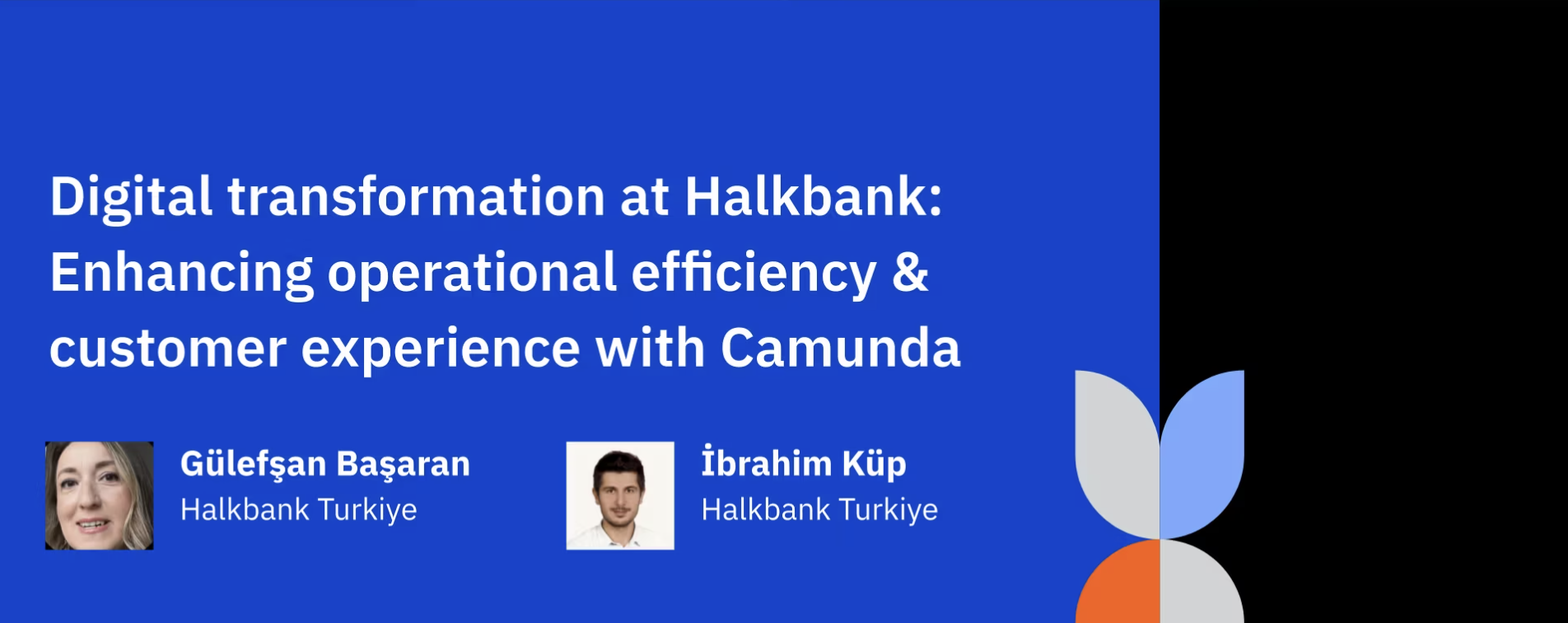
While every industry is faced with changing customer expectations, consumer banking and other financial services are particularly challenged to meet new and heightened customer needs. Consumers want agile, unrestricted, personalized and enjoyable services from their banking providers, with instant or near-instant access to their funds and other products. And if they don’t get the service they expect, they are not afraid to move on to another provider. Pair this high-stakes need to drive customer experiences with a rigorous regulatory environment, and banks are hard-pressed to find meaningful ways to safely and effectively drive digital transformation that really makes a difference.
That’s why Halkbank Turkiye, Turkey’s fourth-largest bank, turned to Camunda-powered process orchestration to delight customers by building a centralized process automation platform to make critical business processes faster, less error-prone, and compliant with the regulatory requirements that keeps consumers and institutions safe. Halkbank now has 22 use cases orchestrated by Camunda, but their money transfer process is where the bank really started to unlock the power that comes from intelligent process orchestration and automation.
While money transfers are fundamental to banking, they present multiple business and operational challenges to banks; there are financial risks to both the customer and to the institution and strict regulatory requirements meant to protect all parties from some of that financial risk. Operationally, the money transfer process is extremely complex, requiring multiple APIs, secondary approvals, and decision points that require intelligent intervention.
At Halkbank especially, the high transaction volume also added to the complexity. Halkbank’s Central operations unit processes 50,000 money transfer transactions per day, with approximately 80% of those transactions received and processed within a peak period between 2:00 PM and 4:00 PM.
This combination of operational complexity, high transaction volume concentrated into peak times, high risk, and strict compliance needs all contributed to a significant load on Halkbank’s processing systems. A high need for manual interventions in the process also kept bank employees from more strategic or valuable work.
To handle these demands efficiently and ultimately drive better customer experience, the core banking software development department and its process management team created a high performance architecture with advanced prioritization mechanisms, dynamic authorization structures, and strong pool management capabilities to tackle their process complexity and speed.
They also incorporated artificial intelligence to power the decision-support systems within the workflow, ensuring accurate data extraction and seamless integration with core banking APIs.
Finally, they used comprehensive real-time dashboards and effective workforce management to increase process transparency and help strengthen business and IT workflow collaboration.
“This collaboration is critically important for such a mission-critical business process,” says Gülefşan Yıldırım Başaran, IT Manager at Halkbank. “We need both working together to design these structures and continuously improve them to provide the best possible solution.”
Gülefşan also noted that the IT and business collaboration was important to give business users the ability to leverage the solution strategically to manage their workforce allocation, especially in crisis situations and peak times, to maximize employee efficiency without sacrificing accuracy.
These requirements made the money transfer process an ideal use case for process orchestration powered by Camunda. Halkbank needed a composable platform that could effortlessly connect AI endpoints, multiple APIs, and intelligent execution and optimization to continuously improve the workflow and with it, both employee experiences and customer engagement in the money transfer process.
With Camunda as the core platform orchestrator, the new money transfer process starts in much the same way as the old process does: with the customer. Customers submit their money transfer orders, and branch officers collect these orders and scan them with a scanner or upload them, which also activates the scanning system. The scanning application saves the orders into the document management system and triggers the money transfer process to begin by calling an API.
Optical character recognition (OCR) converts those scanned documents into text, then the artificial intelligence service reviews the unstructured data and extracts the critical information. This intelligent automation eliminates manual data entry and streamlines the workflow.
Next, the money transfer user task is initiated by task listeners, which also helps reduce manual entry. However, both the original customer order and the information processed through OCR and AI are brought up onscreen simultaneously so users can ensure that information is not missing nor incorrect; if there are issues, users can reconcile those differences. This feature makes the comparison easier for business users and reduces the opportunity for error. From there, the money transfer workflow is completed.
With this new platform, Halkbank has experienced a number of operational improvements that have driven better business results.
Operational improvements include:
And as for those peak processing times? The central operations unit used to stay until 6:30pm in order to process money transfers; now, they can end their day at 4:30pm even with fewer employees working on that process. This results in a conservative estimated 730 hours saved per year – all thanks to a thoughtfully designed and intelligently orchestrated process.
Başaran was proud to note that Halkbank Turkiye was awarded the “best AI powered efficiency award” in Turkey because of the success of their money transfer process and their ability to operationalize AI into their critical workflows through process orchestration.
The team isn’t done improving; they are currently working on incorporating an image-based AI model into the money transfer process. With advanced AI capabilities, the team expects to further increase their full automation rate from 60% to 75%.
The money transfer process is just one element of Halkbank’s core banking platform; the team’s long term ambition is to bring process orchestration to every corner of the bank, as customer expectations continue to grow.
“It is obvious that we will need to handle higher volumes with faster response times without hitting the limitation of a relational database,” İbrahim Küp, Senior Developer explained. This means that the bank will need horizontal scalability and resiliency under pressure—the two main capabilities to fulfill the automation demands of a large scale enterprise.
Camunda © 2025